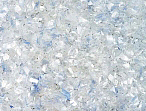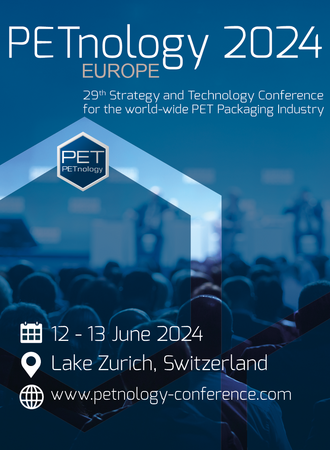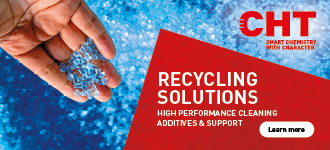Adjustments made
In contrast to the established SSP process for PET pellets, a number of differences must be taken into account in designing an SSP process for PET flakes. Buhler as a leading supplier of SSP systems for virgin PET pellets has made the necessary adjustments. Today, Buhler offers compact flake SSP units for 1 t/h and 2 t/h as well as larger ones, depending on the customer specifications. Thanks to their modular design, smaller flake SSP plants can be integrated in existing buildings – with an outside reactor and material silo.
The process is based on a crystallization and preheating stage in a multichamber fluid bed, followed by continuous thermal treatment in a tower reactor. The crystallizer ensures uniform heating of all particles, crystallization without a risk of agglomeration, and removal of the residual PET dust. The preheated flakes pass continuously through the reactor in a nitrogen countercurrent in order eliminate reaction products and contaminants. The nitrogen from the reactor is first applied as an exchange gas in the crystallizer and then flows through a gas purification system and a dryer before reentering the reactor. By adjusting the residual water content in the process gas to a dew point between – 30 °C and + 10 °C, it is possible to limit the molecular weight increase while maintaining the same high cleaning efficiency. The finished flakes can be rapidly cooled in a fluid-bed cooler or be directly fed to a molding process.
Solid State Polycondensation (SSP) of PET flakes allows the molecular weight of recycled PET to be efficiently increased. At the same time, the PET flakes are purified so that they can be used in applications where the material will be in direct contact with foods. The largest advantage offered by the process is its high reaction and cleaning rate.
| Recycled bottle-grade flakes of polyethylene terephthalate (PET) are used in numerous applications and are considered as a valuable raw material. Alone in Europe, 740,000 metric tons of PET flakes were processed into new fibers, yarns, bottles, film, and other products in 2007. Modern recycling systems supply high-quality PET flakes by sorting, grinding, and washing collected post-consumer PET bottles. |
Preparation prior to recycling
However, these flakes are often not yet suitable for being used in the intended end products. Depending on the final application, residual solid particles still have to be removed in order to satisfy the visual and mechanical requirements. Migration substances must be eliminated to fulfill food laws, and the molecular weight has to be increased in order to meet mechanical and process-related requirements.
In such direct applications, the migration substances should be removed from and the molecular weight increased directly in the PET flakes. Both are accomplished by Solid State Polycondensation (SSP) of PET flakes. Even if no increase in the molecular weight is required, a solids cleaning treatment is still crucial for achieving a PET flake quality that is suitable for applications with direct food contact.








